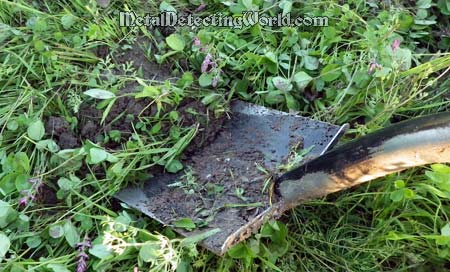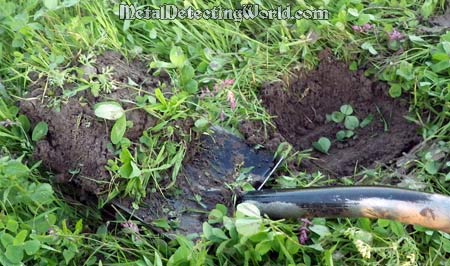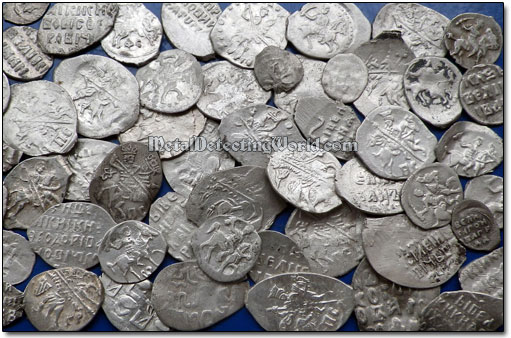Metal Detect Hammered Wire Coins
Recovery Techniques for Retrieving Single Tiny Hammies, page 2
(...CONTINUED from Previous Page)
2) Hard ground surface without grass
Remove a thin layer of dirt from the pinpointed coin spot with your shovel blade holding it almost parallel to the surface. Then again, use the ground cloth on which you place and thin-spread the removed dirt with a coin in it. Now it would be much easier to locate the wire coin using Pinpoint mode or/and a hand-held pinpointer, electronic probe or inline probe. If the hand-held pinpointer is not available, proceed with the recovery technique described in a paragraph #1 above.
3) Ground surface with "light" grass
To retrieve a detected hammered coin, first you pinpoint its exact location, then make four shallow cuts in turf around it; thus, making a small square. While holding the shovel blade almost parallel to the ground, thrust it underneath the turf square, ...

..."free" the "turf slice" by lifting it up a little, ...

...and keep it on the shovel blade while carefully removing it aside.

Let the "turf slice" slide off the shovel blade, without overturning, onto the ground cloth, and scan it with the search coil again to confirm the coin's presence inside. If the "slice" does not hold together, flatten the dirt by stepping on it.
After you determine the coin's exact location using Pinpoint mode and/or a hand-held pinpointer, cut the pinpointed spot - a small clod of turf, out of the turf slice with a knife. Tear the clod into smaller pieces, and use the hand-held pinpointer to find the hammered coin in one of them. If the pinpointer/probe is not available, use the "split-in-two-halves" technique.
This technique is commonly used for retrieving coins/small relics from the dug dirt plugs or dirt piles without a pinpointer. While holding the turf clod above the ground cloth, split it in two halves. Move each half above a search coil to determine which half has a coin inside. Place the coinless half back onto the cloth, and split (if it is possible at this point) another half in two halves again. Repeat these steps until you see the tiny coin in your palm.
Again, using the ground cloth will prevent the coin from dropping down into the grass. If that happens, the process of recovery might take much longer unless you use an electronic probe/pinpointer. In case of losing the coin, proceed with the recovery procedures described in a paragraph #2 above.
Disappearance of a true coin signal sometimes occurs during recovery and may be caused by the following:
1) The coin has dropped out of the dirt plug or the dirt lump during its removal from the hole, or while the "split-in-two-halves" technique was performed. The hammered coin could fall either back into the dug hole or into the grass. In the first case, one should take all loose dirt out of the hole, place it in a thin layer onto the ground cloth or just onto the smooth ground surface that is free of any rocks, branches, dirt lumps or thick vegetation, and scan it with a search coil. To locate a tiny coin in the grass, one should scan the spot with the search coil first and then use a hand-held pinpointer.
2) The coin was initially positioned close to the ground surface, and when the dirt plug was cut out and mistakingly placed upside down on the ground surface, the coin ended up at the bottom part of the plug. And the plug has turned out to be too thick for the coin to be within the Deus' detecting depth range. One should carefully turn the plug over and scan its grassy side (the top) with the search coil. If no audio signal is received, the wire coin most likely have fallen out during overturning, and you should proceed as described in a previous paragraph. It is best to keep the dirt plug in upright position while removing and placing it on the ground.
3) The coin is inside the dirt lump that you move in front of the search coil but too far from the coil to give off a signal. You should carefully rotate your hand holding the lump while moving it in front of the coil until you "catch" the coin signal.
4) The coin was next to an iron nail inside the dirt plug, and after the plug was displaced, broken in parts, or flattened, the nail ended up on top of the coin; thus, masking it completely. In this case, you should mixed up the dirt, flatten it, and scan it with the search coil again. Repeat this step until you get a clear coin signal. Since the Deus is capable of detecting coins next to nails, this case of coin recovery mishap happens very often.
After having metal detected for 20 years, I have mastered my coin recovery technique so well that I do it without thinking and do not use the ground cloth and, in most cases, the electronic pinpointer. A novice should use both the ground cloth and the pinpointer in the beginning just to avoid challenges, save time, and master the recovery technique.
After you retrieve the coin, do not try to remove the dirt off the coin - you will scratch and devalue it! Place your find in a coin container filled with cotton balls.

Do not put the coin in your pocket or pouch along with other finds and dirt, or you will never find it! And do not forget to scan the hole again before covering and leaving it.
At home, soak the coin in soapy water so the dirt will fall off, and brush it with a soft toothbrush and toothpaste. These silver wire coins do not require any more cleaning than that as they are of high silver content. After simple rinsing with water, they will be as shiny as if they have just been hammered.

Happy Wire Coin Shooting!
Back to Detect Hammered Coins Index page